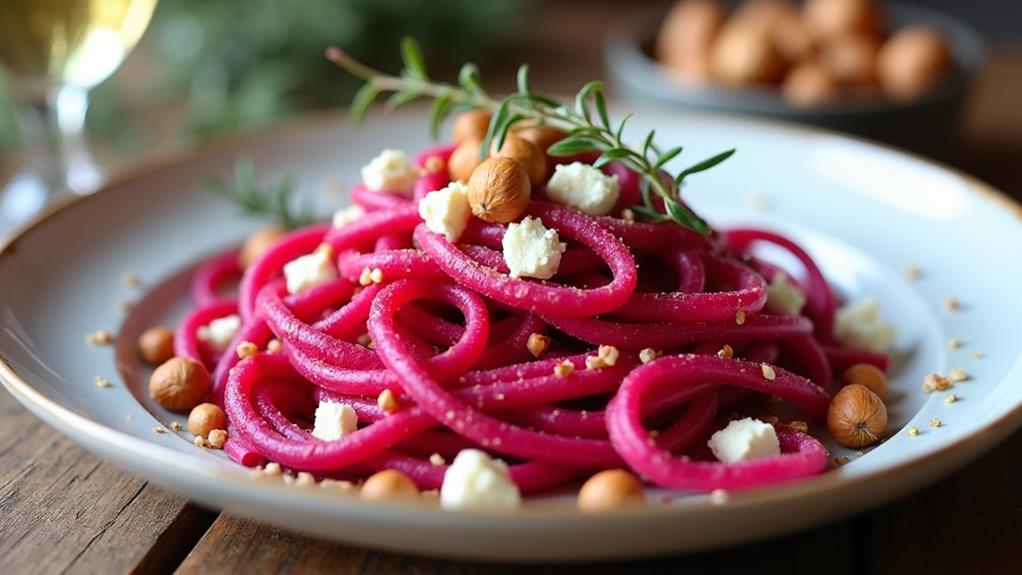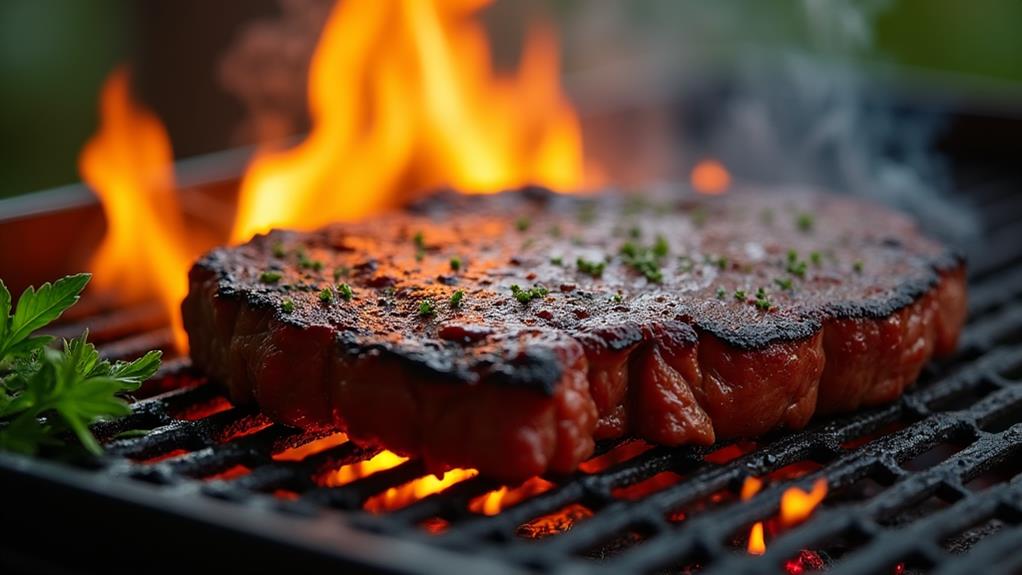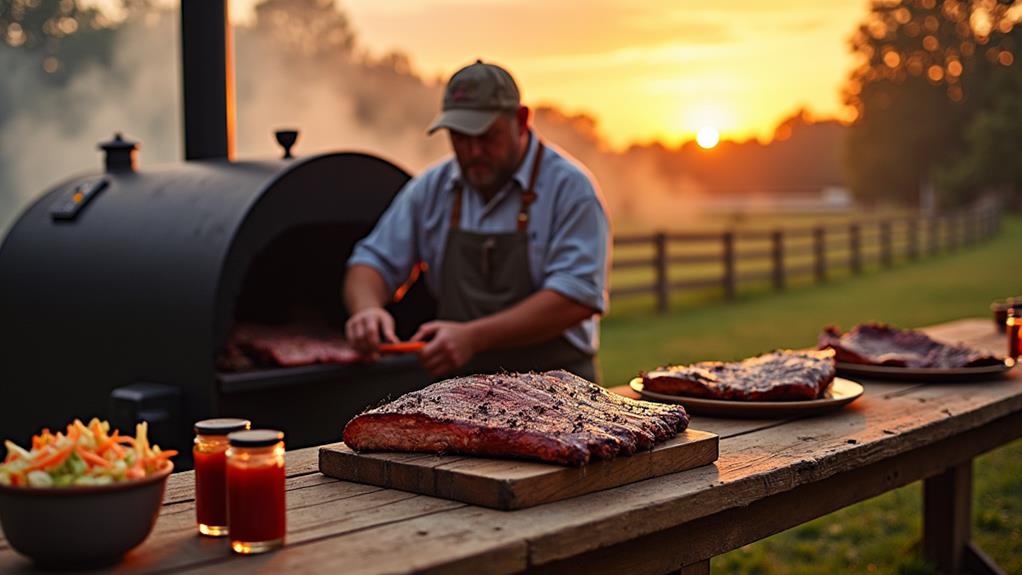Like Aphrodite rising from the sea, this vibrant beet fettuccine dish promises to captivate your senses. You'll find yourself drawn to the striking pink hue of the pasta, enriched with earthy beets and complemented by creamy goat cheese. The addition of toasted hazelnuts introduces a delightful crunch, elevating the texture profile. As you contemplate this gourmet creation, you might wonder about its origins or the intricacies of its preparation. There's more to this sophisticated yet simple meal than meets the eye, and you're about to uncover the secrets behind its allure.
Key Takeaways
- Beet fettuccine combines pasta with grated beets, goat cheese, and hazelnuts for a vibrant, flavorful dish.
- Cook fettuccine al dente, adding grated beets during the last two minutes of boiling.
- Toast hazelnuts in a dry skillet until fragrant and lightly browned for added crunch.
- Toss pasta and beets with olive oil, goat cheese, and hazelnuts, using reserved pasta water for sauce consistency.
- The dish offers a balance of earthy, tangy, and nutty flavors with a striking pink color.
History
While the exact origins of beet fettuccine are unclear, this vibrant dish is a modern twist on traditional Italian pasta. You'll find that the incorporation of beets into pasta dough has gained popularity in recent years, as chefs and home cooks alike have sought to create visually striking and nutritionally dense meals.
The use of beets in cooking isn't new, though; these root vegetables have been cultivated for thousands of years, with evidence of their consumption dating back to ancient civilizations.
In Italy, pasta-making has been an art form for centuries, with different regions developing their own unique shapes and recipes. The addition of beets to pasta dough is a relatively recent innovation, likely inspired by the trend of using natural ingredients to color and flavor foods.
You'll notice that this adaptation combines the best of both worlds: the comforting familiarity of Italian pasta with the earthy sweetness of beets. The pairing of goat cheese and hazelnuts with beet pasta isn't traditional, but it's a delicious combination that showcases how modern cuisine continues to evolve, blending flavors and techniques from various culinary traditions.
Recipe
Beet Fettuccine with Hazelnuts and Goat Cheese is a visually stunning and flavorful dish that combines the earthiness of beets with the creaminess of goat cheese and the crunch of toasted hazelnuts. This unique twist on traditional pasta creates a vibrant, pink-hued meal that's sure to impress both the eyes and the taste buds.
This recipe uses only five key ingredients, making it an accessible yet elegant option for home cooks. The natural sweetness of the beets is balanced by the tangy goat cheese, while the hazelnuts add a delightful texture and nutty flavor to the dish. The result is a harmonious blend of tastes and textures that elevates a simple pasta meal into a gourmet experience.
- 12 oz (340g) fettuccine pasta
- 2 medium beets, peeled and grated (about 2 cups or 250g)
- 4 oz (113g) goat cheese, crumbled
- 1/2 cup (70g) hazelnuts, roughly chopped
- 2 tablespoons (30ml) olive oil
Cook the fettuccine in a large pot of salted boiling water according to package instructions until al dente. While the pasta is cooking, toast the hazelnuts in a dry skillet over medium heat until fragrant and lightly browned.
In the last 2 minutes of cooking the pasta, add the grated beets to the boiling water. Drain the pasta and beets, reserving 1/2 cup of the cooking water. Return the pasta and beets to the pot, add the olive oil, and toss to combine. Gradually add the reserved cooking water as needed to create a sauce.
Gently fold in the crumbled goat cheese and toasted hazelnuts, allowing the residual heat to melt the cheese slightly. Serve immediately.
For best results, choose fresh, firm beets with vibrant color. If you prefer a smoother sauce, you can blend the cooked beets with some of the pasta water before adding them to the dish.
To enhance the flavor profile, consider adding a splash of balsamic vinegar or a sprinkle of fresh herbs like thyme or basil. For a gluten-free option, substitute the fettuccine with your favorite gluten-free pasta.
Remember that beets will stain, so use caution when handling them and consider wearing gloves to avoid pink-stained hands.
Cooking Steps
To create this vibrant beet fettuccine dish, you'll begin by cooking the pasta until it's al dente and toasting the hazelnuts to enhance their flavor.
While the pasta cooks, you'll add grated beets to the water, then drain everything while reserving some cooking liquid to create a silky sauce.
Step 1. Cook Pasta Until Al Dente
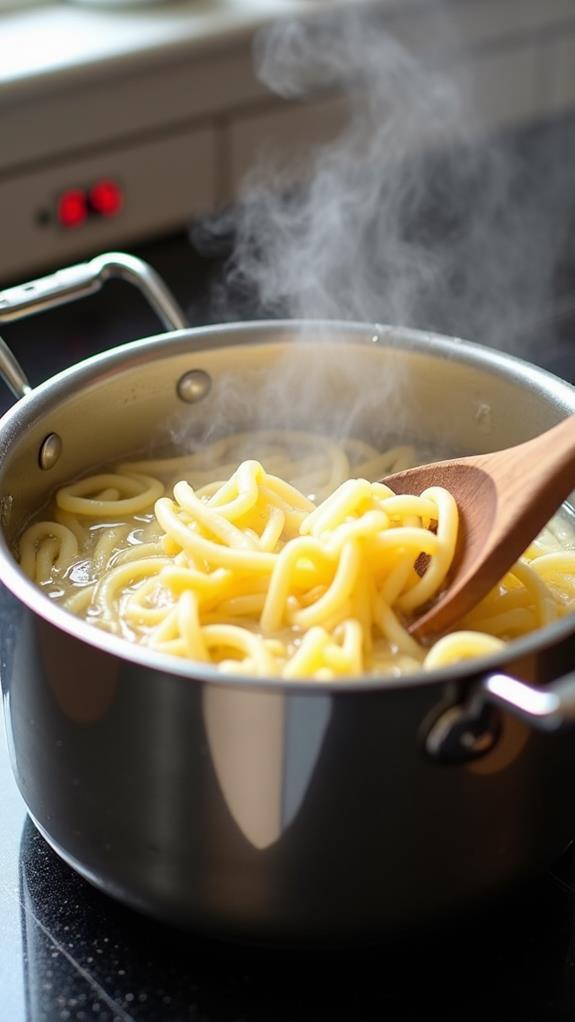
Begin by bringing a large pot of salted water to a rolling boil. Once the water's bubbling vigorously, carefully add your fettuccine pasta.
You'll want to stir it gently for the first minute to prevent the noodles from sticking together. Keep an eye on the clock, as cooking time can vary depending on the brand and thickness of your pasta.
To achieve the perfect al dente texture, you'll need to taste-test the pasta periodically. Start checking about two minutes before the package's suggested cooking time. The pasta should be firm to the bite but not crunchy.
It's crucial not to overcook, as you'll be adding the pasta back to the pot with other ingredients later. When it's almost ready, add the grated beets to the boiling water. They'll need about two minutes to cook and infuse the pasta with their vibrant color.
Once you're satisfied with the texture, quickly drain the pasta and beets in a colander, reserving some of the cooking water for the sauce. Don't rinse the pasta, as the starch will help the sauce adhere better.
Step 2. Toast Hazelnuts Until Fragrant
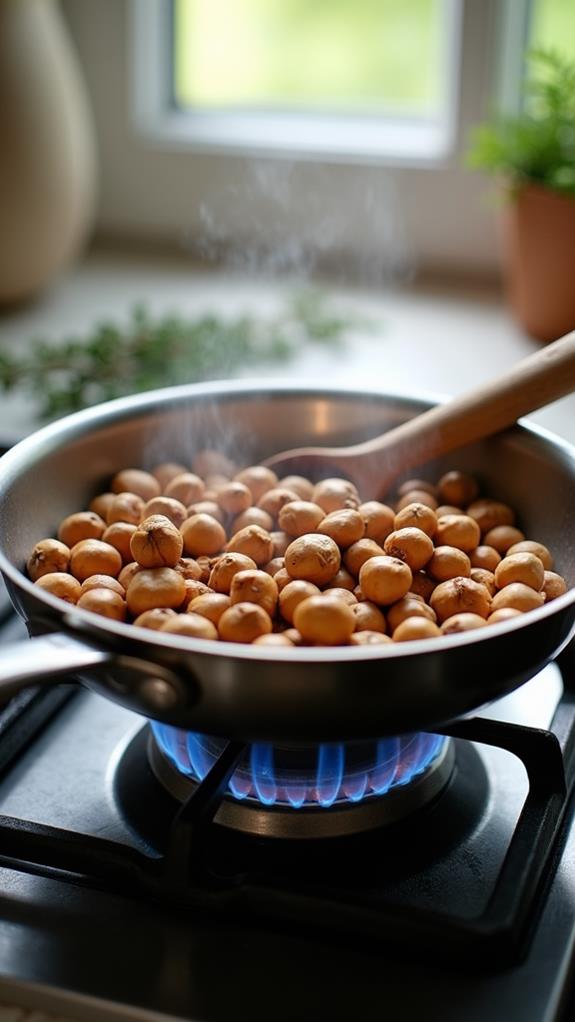
While your pasta is cooking, turn your attention to the hazelnuts. You'll want to toast them to enhance their flavor and create a satisfying crunch.
Start by placing a dry skillet over medium heat. Once the pan is hot, add the roughly chopped hazelnuts in a single layer. Don't overcrowd the pan, as this can lead to uneven toasting.
Keep a close eye on the nuts as they toast, shaking the pan gently every 30 seconds or so to ensure even browning. You'll notice a wonderful nutty aroma filling your kitchen as the hazelnuts begin to toast. This fragrance is your cue that they're nearly ready.
The entire process should take about 5-7 minutes, depending on your stove's heat.
Once the hazelnuts have turned a light golden brown and smell fragrant, immediately remove them from the heat. Be careful not to let them burn, as they can quickly go from perfectly toasted to bitter and overcooked.
Transfer the toasted hazelnuts to a plate to cool slightly before adding them to your beet fettuccine.
Step 3. Add Beets to Pasta Water
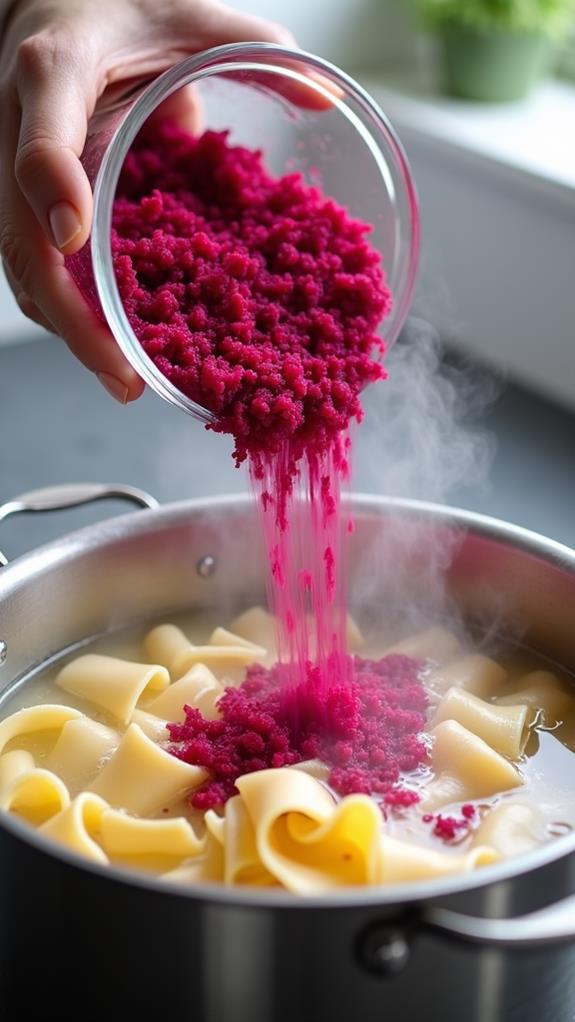
In the final minutes of pasta cooking, it's time to introduce the star ingredient: grated beets.
You'll want to add your prepared beets to the boiling pasta water about two minutes before the pasta is done. This brief cooking time allows the beets to soften slightly while retaining their vibrant color and earthy flavor.
As you add the beets, you'll notice the water turning a beautiful shade of pink. Don't worry; this is exactly what you want! The beets will infuse the pasta with their rich hue, creating a visually stunning dish.
Stir gently to ensure the beets are evenly distributed among the pasta strands. Keep a close eye on the pot during these final moments, as overcooking can lead to mushy beets and pasta.
When the pasta is al dente and the beets are just tender, it's time to drain. Remember to reserve some of the cooking water, as you'll need it later to create a silky sauce that coats every strand of your beet-infused fettuccine.
Step 4. Drain and Reserve Water
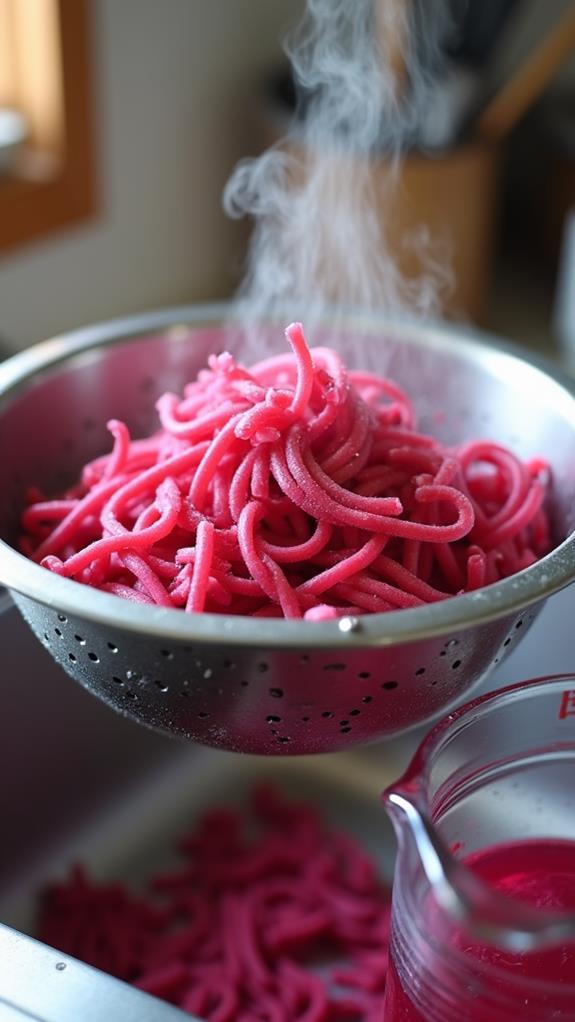
Now that your pasta and beets have reached the perfect consistency, it's time to drain them. Grab your colander and place it in the sink. Before you pour out the contents of your pot, don't forget to reserve about 1/2 cup of the cooking water. This starchy liquid will be crucial for creating a silky sauce later on.
Carefully pour the pasta and beets into the colander, allowing the excess water to drain away. The pasta should be al dente, with a slight bite to it, while the beets will be tender but not mushy. As you drain, you'll notice the vibrant pink color that the beets have imparted to the pasta – it's a stunning visual effect that'll make your dish even more appealing.
Once drained, return the pasta and beets to the pot. The residual heat will help keep everything warm as you move on to the next steps.
Don't rinse the pasta, as the starch on its surface will help the sauce cling better. You're now ready to combine the remaining ingredients and create your delicious beet fettuccine.
Step 5. Combine Ingredients, Create Sauce
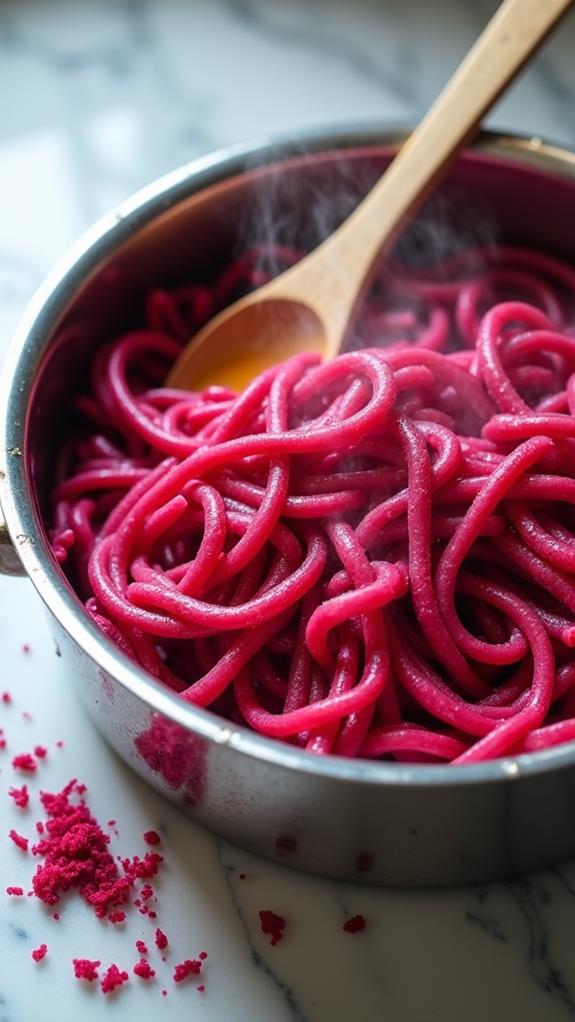
The sauce-making process begins with the drained pasta and beets in your pot. Add the olive oil and toss everything together, ensuring the pasta and beets are evenly coated. This step helps distribute the beet's vibrant color throughout the dish while preventing the pasta from sticking together.
Next, you'll gradually add the reserved pasta water. Start with a small amount, about a quarter cup, and mix well. The starchy water will combine with the olive oil and beet juice to create a light, silky sauce.
Add more water as needed until you achieve your desired consistency. Remember, the sauce will thicken slightly as it cools.
Now, it's time to incorporate the goat cheese and hazelnuts. Gently fold these ingredients into the pasta mixture. The residual heat will soften the cheese, allowing it to meld with the sauce and coat the pasta.
Be careful not to overmix, as you want to maintain some texture from the crumbled cheese and toasted nuts. Your beet fettuccine is now ready to serve, boasting a beautiful pink hue and a harmonious blend of flavors and textures.
Final Thoughts
Despite its simplicity, this Beet Fettuccine recipe offers a sophisticated dining experience. You'll find that the vibrant pink color and unique flavor combination make it an impressive dish for any occasion.
Don't be afraid to experiment with the recipe, adjusting the amount of goat cheese or hazelnuts to suit your taste preferences. You can also try different pasta shapes or add extra vegetables for more texture and nutrition.
Remember to handle the beets carefully to avoid staining, and consider wearing gloves during preparation. If you're short on time, you can use pre-cooked beets, but fresh ones will give you the best flavor and color.
For a more intense beet flavor, roast them before grating. You'll find that this dish pairs well with a crisp white wine or a light-bodied red.
Leftovers can be enjoyed cold as a pasta salad or gently reheated with a splash of water or cream. With its balance of earthy, tangy, and nutty flavors, this Beet Fettuccine is sure to become a favorite in your recipe collection.

